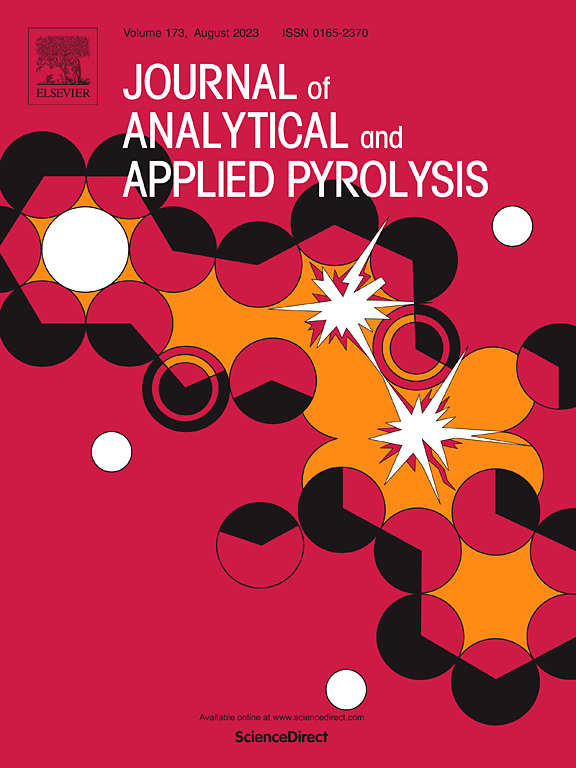氧空位MoO3-x量子点的精确催化提高Al@AP的反应性和燃烧效率
IF 5.8
2区 化学
Q1 CHEMISTRY, ANALYTICAL
引用次数: 0
摘要
铝作为固体火箭推进剂的初级金属燃料,可以显著提高固体火箭推进剂的能量密度和比冲,但其不完全燃烧导致其能量释放性能不理想。燃料/氧化剂界面控制策略可有效提高al基复合材料的反应效率,从而改善固体推进剂的燃烧性能。高氯酸铵是固体推进剂中常用的高能氧化剂,其热分解行为直接影响推进剂的燃烧特性。燃烧催化剂的加入可以降低AP的热分解温度,提高AP的热反应活性。作为一种新兴的催化材料,具有氧空位的MoO3-x量子点(QDs)具有高比表面和强电荷吸附能力,这使得它在催化AP方面具有很大的潜力。本研究引入MoO3-x量子点作为催化剂,并与传统的纳米金属氧化物(MxOy)进行了比较。采用喷雾干燥法制备了以聚多巴胺为界面层的球形Al@AP/MxOy复合材料。研究了Al@AP/MxOy的颗粒形态、热分解动力学和着火性能。进一步分析了复合材料凝聚燃烧产物的相组成、形貌和粒度分布。CCPs中颗粒尺寸的减小和未反应Al含量的减少表明Al与AP之间的燃烧效率提高。特别是Al@AP/MoO3-x具有较高的反应热、较低的热分解温度和较小的CCPs粒径分布,这共同表明MoO3-x能够提高Al@AP复合材料的热反应性,从而提高燃烧效率。本文章由计算机程序翻译,如有差异,请以英文原文为准。
Enhancing the reactivity and combustion efficiency of Al@AP by precise catalysis of MoO3-x quantum dots with oxygen vacancy
Aluminum (Al) can significantly improve the energy density and specific impulse (Isp) of solid rocket propellants as the primary metal fuel, but its incomplete combustion results in an undesirable energy release performance. The strategy of fuel/oxidizer interfacial control has been proved to effectively enhance the reaction efficiency of Al-based composites and thus improving the combustion properties of solid propellants. Ammonium perchlorate (AP) is commonly used as a high-energy oxidizer in solid propellant, and its thermal decomposition behavior directly affects the combustion characteristics of propellants. The addition of combustion catalysts can decrease thermal decomposition temperature and increase thermal reactivity of AP. As an emerging catalytic material, MoO3-x quantum dots (QDs) with oxygen vacancies possess a high specific surface and strong charge adsorption capacity, which renders it a great potential for catalyzing AP. In this study, MoO3-x QDs were introduced as catalyst and compared with traditional nano-metal oxides (MxOy), the spherical Al@AP/MxOy composites with polydopamine as interfacial layer were prepared by spray drying method. The particle morphology, thermal decomposition kinetics and ignition properties of Al@AP/MxOy were investigated. The phase composition, morphology and particle size distribution for the condensed combustion products of composites were further analyzed. The decreased particle size and less unreacted Al content in CCPs indicated the increase of combustion efficiency between Al and AP. In particular, Al@AP/MoO3-x has the higher heat of reaction, lower thermal decomposition temperature and small CCPs particle size distribution, which collectively suggested that the MoO3-x is capable to improve the thermal reactivity of Al@AP composites with a higher combustion efficiency.
求助全文
通过发布文献求助,成功后即可免费获取论文全文。
去求助
来源期刊
CiteScore
9.10
自引率
11.70%
发文量
340
审稿时长
44 days
期刊介绍:
The Journal of Analytical and Applied Pyrolysis (JAAP) is devoted to the publication of papers dealing with innovative applications of pyrolysis processes, the characterization of products related to pyrolysis reactions, and investigations of reaction mechanism. To be considered by JAAP, a manuscript should present significant progress in these topics. The novelty must be satisfactorily argued in the cover letter. A manuscript with a cover letter to the editor not addressing the novelty is likely to be rejected without review.

 求助内容:
求助内容: 应助结果提醒方式:
应助结果提醒方式:


